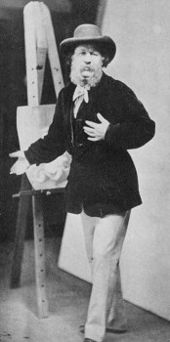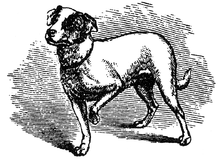Oscar Gustave Rejlander
Oscar Gustave Rejlander (* Sweden 1813 , † January 18, 1875 in Clapham, London ) was a Swedish-British painter and pioneer of artistic photography in the Victorian era .
Life
His exact date of birth is unknown, it was probably 1813. He was the son of Carl Gustaf Rejlander, a stonemason and Swedish officer. He studied art in Rome , where he saw photographs of the famous buildings. After moving to Lincoln , England , he quit painting to become a photographer after seeing the accuracy of a photograph showing the folds of a cuff. According to other statements, he was inspired by an assistant to Fox Talbot .
Rejlander began working as a portrait photographer in Wolverhampton around 1846 . Around 1850 he got to know the collodion wet plate process and the fast wax paper process (see → calotype ) with Nicholas Henneman in London and opened a portrait studio around this time. Among other things, he made erotic recordings , with his models being the circus girls of Mme Wharton and street children and child prostitutes - his Charlotte Baker series was well known.
Rejlander undertook many experiments to perfect his representations, including combination printing around 1853, which he may have invented. He was a friend of the mathematician Charles Lutwidge Dodgson, better known by his stage name as a man of letters and photographer, Lewis Carroll , who collected Rejlander's early childhood photographs and corresponded with him about technical problems. In 1863, Rejlander created one of the most famous and best-known portraits of Carroll.
His early work did not quite correspond to that of his later recognized work, but he took part in the Paris World Exhibition in 1855 . In 1857 he created his most famous work, the allegorical photo The Two Ways of Life . It was a photo montage of 32 pictures, which was difficult to carry out with the technical possibilities at the time and which took about six weeks to create. It was first exhibited at the "First Manchester Art Treasures Exhibition" in 1857.
The partial nudity of some of the figures in the picture was scolded by some critics as indecent, and those more familiar with Rejlander's commercial work suspected him of using prostitutes as cheap models. But the accusation of “indecency” disappeared when Queen Victoria ordered a copy to be given to her husband Prince Albert .
Despite this royal patronage , the controversy over The Two Ways of Life in Scotland in 1858 led to a breakaway of a large group of the "Photographic Society of Scotland" and in 1861 they founded the "Edinburgh Photographic Society". They expressed their opposition to the exhibited photo by covering half of the picture. It was later exhibited by the Birmingham Photographic Society without censorship or criticism . In 1866 the "Photographic Society of Scotland" backed out and invited Rejlander to a large banquet in his honor at an exhibition that showed many of his pictures.

The success of The Two Ways of Life and membership of the Royal Photographic Society in London gave Rejlander an entrance to London society. He moved his studio to Malden Road in London around 1862 and made further experiments with photo montages, photo manipulation and retouching . He became a leading expert in photographic technology, lecturing and publishing. His portfolios were sold in bookshops and art dealers. As photo opportunities in London he took homeless street children and expressed his social protest in photographs such as Poor Joe and Homeless .
In 1862 Rejlander married Mary Bull, who became his business partner for 24 years. Mary had been his model in Wolverhampton when she was 14 years old.
Lewis Carroll visited Rejlander's studio on Malden Road in 1863, which inspired him to open his own studio. Rejlander visited the Isle of Wight around 1863 and worked with photographer Julia Margaret Cameron .
Some of Rejlander's photographs were acquired by well-known Victorian painters, such as Lawrence Alma-Tadema , and were used as models for their pictures. In 1872 he illustrated Darwin's classic treatise The Expression of the Emotions in Man and Animals .
He became seriously ill in 1874 and died in 1875. In order to reduce his debts and the costs of the funeral, the Edinburgh Photographic Society gave his widow donations and helped establish the Rejlander Memorial Fund.
Oscar Rejlander's ideas and techniques were taken up by other photographers and he was considered the "father of fine art photography".
literature
- Marc Wilken: Rejlander, Oscar Gustave . In: General Artist Lexicon . The visual artists of all times and peoples (AKL). Volume 98, de Gruyter, Berlin 2018, ISBN 978-3-11-023263-9 , pp. 207 f.
- David Elliott (Ed.) Oscar Gustave Rejlander. 1813 (?) - 1875. Modern Museum / Royal Photographic Society, Sweden, 1998. (exhibition catalog)
- E. Y. Jones. Father of Art Photography: O. G. Rejlander 1813-75 . David & Charles 1973, ISBN 0-7153-6077-9
- Graham Ovenden / Robert Melville. Victorian Children (Academy Editions, 1972)
Web links
- Works of Rejlander at zeno.org
- History of Photography ( Memento from January 11, 2001 in the Internet Archive )
- Oscar Gustave Rejlander at artfacts.net
- Search for Oscar Gustave Rejlander in the SPK digital portal of the Prussian Cultural Heritage Foundation
- Oscar Gustave Rejlander at photography-now.com
Individual evidence
- ↑ See web link Oscar Gustave Rejlander at Photography-Now
| personal data | |
|---|---|
| SURNAME | Rejlander, Oscar Gustave |
| ALTERNATIVE NAMES | Rejlander, OG |
| BRIEF DESCRIPTION | Swedish-British pioneer of fine art photography in the Victorian era |
| DATE OF BIRTH | 1813 |
| PLACE OF BIRTH | Sweden |
| DATE OF DEATH | January 18, 1875 |
| Place of death | Clapham, London |



